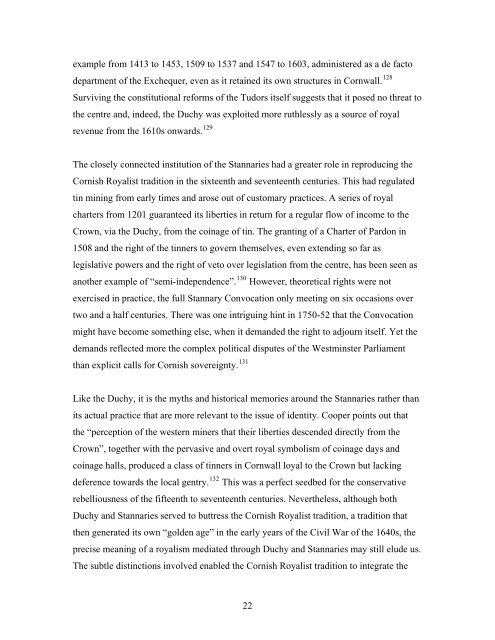Britishness, what it is and what it could be, is now high on both ...
Britishness, what it is and what it could be, is now high on both ...
Britishness, what it is and what it could be, is now high on both ...
Create successful ePaper yourself
Turn your PDF publications into a flip-book with our unique Google optimized e-Paper software.
example from 1413 to 1453, 1509 to 1537 <str<strong>on</strong>g>and</str<strong>on</strong>g> 1547 to 1603, admin<str<strong>on</strong>g>is</str<strong>on</strong>g>tered as a de facto<br />
department of the Exchequer, even as <str<strong>on</strong>g>it</str<strong>on</strong>g> retained <str<strong>on</strong>g>it</str<strong>on</strong>g>s own structures in Cornwall. 128<br />
Surviving the c<strong>on</strong>st<str<strong>on</strong>g>it</str<strong>on</strong>g>uti<strong>on</strong>al reforms of the Tudors <str<strong>on</strong>g>it</str<strong>on</strong>g>self suggests that <str<strong>on</strong>g>it</str<strong>on</strong>g> posed no threat to<br />
the centre <str<strong>on</strong>g>and</str<strong>on</strong>g>, indeed, the Duchy was explo<str<strong>on</strong>g>it</str<strong>on</strong>g>ed more ruthlessly as a source of royal<br />
revenue from the 1610s <strong>on</strong>wards. 129<br />
The closely c<strong>on</strong>nected inst<str<strong>on</strong>g>it</str<strong>on</strong>g>uti<strong>on</strong> of the Stannaries had a greater role in reproducing the<br />
Corn<str<strong>on</strong>g>is</str<strong>on</strong>g>h Royal<str<strong>on</strong>g>is</str<strong>on</strong>g>t trad<str<strong>on</strong>g>it</str<strong>on</strong>g>i<strong>on</strong> in the sixteenth <str<strong>on</strong>g>and</str<strong>on</strong>g> seventeenth centuries. Th<str<strong>on</strong>g>is</str<strong>on</strong>g> had regulated<br />
tin mining from early times <str<strong>on</strong>g>and</str<strong>on</strong>g> arose out of customary practices. A series of royal<br />
charters from 1201 guaranteed <str<strong>on</strong>g>it</str<strong>on</strong>g>s li<str<strong>on</strong>g>be</str<strong>on</strong>g>rties in return for a regular flow of income to the<br />
Crown, via the Duchy, from the coinage of tin. The granting of a Charter of Pard<strong>on</strong> in<br />
1508 <str<strong>on</strong>g>and</str<strong>on</strong>g> the right of the tinners to govern themselves, even extending so far as<br />
leg<str<strong>on</strong>g>is</str<strong>on</strong>g>lative powers <str<strong>on</strong>g>and</str<strong>on</strong>g> the right of veto over leg<str<strong>on</strong>g>is</str<strong>on</strong>g>lati<strong>on</strong> from the centre, has <str<strong>on</strong>g>be</str<strong>on</strong>g>en seen as<br />
another example of “semi-independence”. 130 However, theoretical rights were not<br />
exerc<str<strong>on</strong>g>is</str<strong>on</strong>g>ed in practice, the full Stannary C<strong>on</strong>vocati<strong>on</strong> <strong>on</strong>ly meeting <strong>on</strong> six occasi<strong>on</strong>s over<br />
two <str<strong>on</strong>g>and</str<strong>on</strong>g> a half centuries. There was <strong>on</strong>e intriguing hint in 1750-52 that the C<strong>on</strong>vocati<strong>on</strong><br />
might have <str<strong>on</strong>g>be</str<strong>on</strong>g>come something else, when <str<strong>on</strong>g>it</str<strong>on</strong>g> dem<str<strong>on</strong>g>and</str<strong>on</strong>g>ed the right to adjourn <str<strong>on</strong>g>it</str<strong>on</strong>g>self. Yet the<br />
dem<str<strong>on</strong>g>and</str<strong>on</strong>g>s reflected more the complex pol<str<strong>on</strong>g>it</str<strong>on</strong>g>ical d<str<strong>on</strong>g>is</str<strong>on</strong>g>putes of the Westminster Parliament<br />
than explic<str<strong>on</strong>g>it</str<strong>on</strong>g> calls for Corn<str<strong>on</strong>g>is</str<strong>on</strong>g>h sovereignty. 131<br />
Like the Duchy, <str<strong>on</strong>g>it</str<strong>on</strong>g> <str<strong>on</strong>g>is</str<strong>on</strong>g> the myths <str<strong>on</strong>g>and</str<strong>on</strong>g> h<str<strong>on</strong>g>is</str<strong>on</strong>g>torical memories around the Stannaries rather than<br />
<str<strong>on</strong>g>it</str<strong>on</strong>g>s actual practice that are more relevant to the <str<strong>on</strong>g>is</str<strong>on</strong>g>sue of ident<str<strong>on</strong>g>it</str<strong>on</strong>g>y. Cooper points out that<br />
the “percepti<strong>on</strong> of the western miners that their li<str<strong>on</strong>g>be</str<strong>on</strong>g>rties descended directly from the<br />
Crown”, together w<str<strong>on</strong>g>it</str<strong>on</strong>g>h the pervasive <str<strong>on</strong>g>and</str<strong>on</strong>g> overt royal symbol<str<strong>on</strong>g>is</str<strong>on</strong>g>m of coinage days <str<strong>on</strong>g>and</str<strong>on</strong>g><br />
coinage halls, produced a class of tinners in Cornwall loyal to the Crown but lacking<br />
deference towards the local gentry. 132 Th<str<strong>on</strong>g>is</str<strong>on</strong>g> was a perfect seed<str<strong>on</strong>g>be</str<strong>on</strong>g>d for the c<strong>on</strong>servative<br />
re<str<strong>on</strong>g>be</str<strong>on</strong>g>lliousness of the fifteenth to seventeenth centuries. Nevertheless, although <strong>both</strong><br />
Duchy <str<strong>on</strong>g>and</str<strong>on</strong>g> Stannaries served to buttress the Corn<str<strong>on</strong>g>is</str<strong>on</strong>g>h Royal<str<strong>on</strong>g>is</str<strong>on</strong>g>t trad<str<strong>on</strong>g>it</str<strong>on</strong>g>i<strong>on</strong>, a trad<str<strong>on</strong>g>it</str<strong>on</strong>g>i<strong>on</strong> that<br />
then generated <str<strong>on</strong>g>it</str<strong>on</strong>g>s own “golden age” in the early years of the Civil War of the 1640s, the<br />
prec<str<strong>on</strong>g>is</str<strong>on</strong>g>e meaning of a royal<str<strong>on</strong>g>is</str<strong>on</strong>g>m mediated through Duchy <str<strong>on</strong>g>and</str<strong>on</strong>g> Stannaries may still elude us.<br />
The subtle d<str<strong>on</strong>g>is</str<strong>on</strong>g>tincti<strong>on</strong>s involved enabled the Corn<str<strong>on</strong>g>is</str<strong>on</strong>g>h Royal<str<strong>on</strong>g>is</str<strong>on</strong>g>t trad<str<strong>on</strong>g>it</str<strong>on</strong>g>i<strong>on</strong> to integrate the<br />
22
















